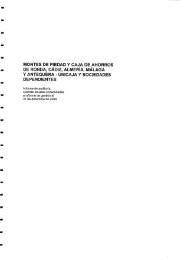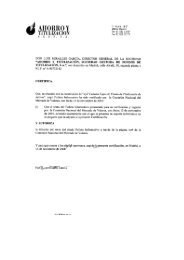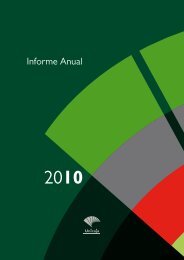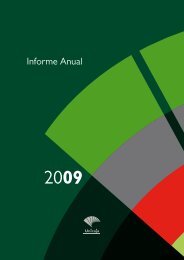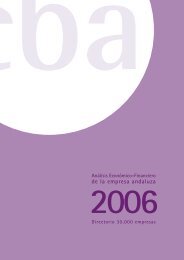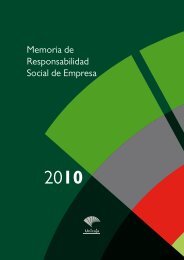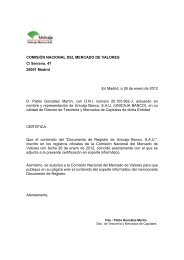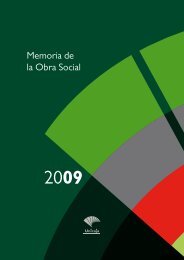Alcance y perfil de la memoria - Unicaja
Alcance y perfil de la memoria - Unicaja
Alcance y perfil de la memoria - Unicaja
You also want an ePaper? Increase the reach of your titles
YUMPU automatically turns print PDFs into web optimized ePapers that Google loves.
Anexo. Metodología<br />
Anexo. Metodología<br />
Cálculo <strong>de</strong> <strong>la</strong>s emisiones<br />
indirectas <strong>de</strong> CO 2<br />
El cálculo <strong>de</strong> <strong>la</strong>s emisiones se basa en <strong>la</strong> metodología y principios el Greenhouse<br />
Gas Protocol Corporate Accounting and Reporting Standard y en <strong>la</strong>s herramientas<br />
<strong>de</strong> cálculo correspondientes a “activida<strong>de</strong>s <strong>de</strong> oficina” y “emisiones proce<strong>de</strong>ntes<br />
<strong>de</strong> combustión móvil (transporte)”, <strong>de</strong>sarrol<strong>la</strong>dos por World Business Council<br />
for Sustainable Development (WBCSD) y World Resources Institute (WRI).<br />
1. Consumo <strong>de</strong> electricidad<br />
Las emisiones indirectas <strong>de</strong> CO 2<br />
producidas por el consumo <strong>de</strong> electricidad<br />
se han calcu<strong>la</strong>do según el último factor <strong>de</strong> emisión publicado por GHG Protocol,<br />
correspondiente a España y al año 2005 - 394,298 gramos CO 2<br />
/ kWh-.<br />
(Fuente: International Energy Agency -“CO 2<br />
Emissions from Fuel Combustion.<br />
ed. 2007”).<br />
2. Tras<strong>la</strong>dos al centro <strong>de</strong> trabajo<br />
Para el cálculo <strong>de</strong> <strong>la</strong>s emisiones <strong>de</strong> CO 2<br />
producidas por el <strong>de</strong>sp<strong>la</strong>zamiento <strong>de</strong><br />
los empleados al centro <strong>de</strong> trabajo se han utilizado <strong>la</strong>s pautas <strong>de</strong> comportamiento<br />
<strong>de</strong> una muestra representativa <strong>de</strong> empleados estudiada en 2005 y se ha<br />
ajustado con <strong>la</strong>s variaciones habidas en <strong>la</strong> p<strong>la</strong>ntil<strong>la</strong> en estos tres últimos años,<br />
teniendo en cuenta <strong>la</strong>s siguientes consi<strong>de</strong>raciones:<br />
X X Combustible: El 64% <strong>de</strong> los vehículos <strong>de</strong> <strong>la</strong> muestra es diesel y el 36% es<br />
gasolina, y los factores <strong>de</strong> emisión utilizados son 2,68 kg <strong>de</strong> CO 2<br />
/ litro y 2,34<br />
kg <strong>de</strong> CO 2<br />
/ litro, respectivamente.<br />
X X Tamaño <strong>de</strong> vehículo: gran<strong>de</strong>, 8,5%; mediano 79,9% y pequeño 11,6%.<br />
X X Trayectos recorridos: 2 tras<strong>la</strong>dos (ida/vuelta) al día durante cinco días a <strong>la</strong><br />
semana.<br />
X X Distancia al trabajo: Según los recorridos proporcionados por <strong>la</strong> encuesta.<br />
3. Viajes <strong>de</strong> negocio<br />
Los factores <strong>de</strong> emisión utilizados son los siguientes:<br />
Avión: Distancia media: 0,13 kg <strong>de</strong> CO 2<br />
/ pasajero y kilómetro.<br />
Tren: 0,10 kg CO 2<br />
/ pasajero y kilómetro.<br />
113 | MEMORIA DE RESPONSABILIDAD SOCIAL DE EMPRESA UNICAJA 2008



